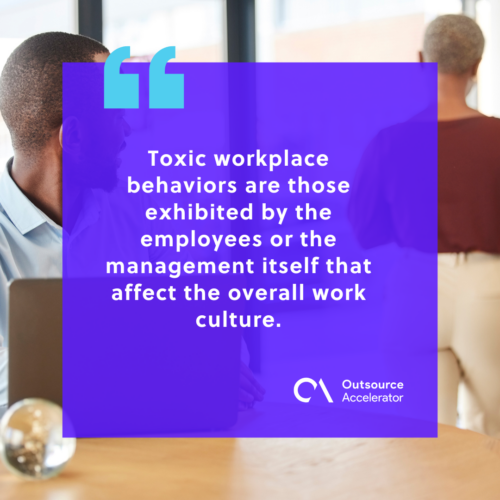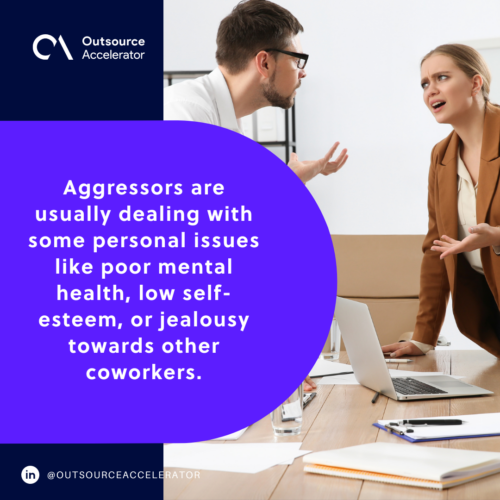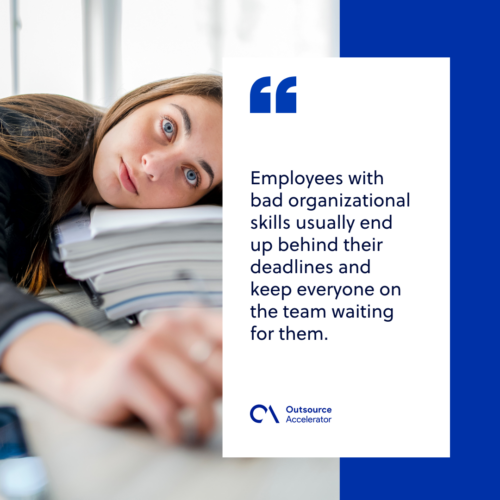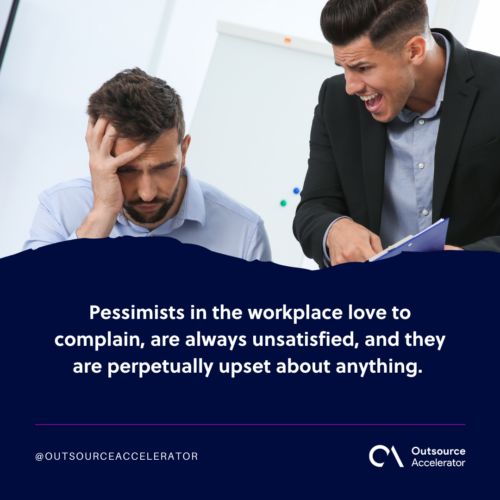11 toxic workplace behaviors and how you can address them

There’s no such thing as a perfect work culture. But as a leader, you would want the kind of work environment where everyone can work together effectively and peacefully.
Unfortunately, a bad workplace is becoming prevalent in today’s businesses. In a study on 14,000 employees, Harvard Business Review has revealed that experiencing uncivil behaviors have resulted in over half of them performing poorly or losing commitment to the job.
Toxic behaviors will lead to a dysfunctional workplace and, if left unaddressed, may end in the downfall of your organization.
You should be able to distinguish toxic workplace behaviors early on and plan what you can do to properly address them.
In this article, we’ll talk you through the top 11 toxic workplace behaviors that you shouldn’t dismiss.
More so, we’ll give some tips about what you can do to prevent these toxic workplace behaviors from destroying your organization.
How can you spot toxic workplace behaviors?
Toxic workplace behaviors are those exhibited by the employees or the management itself that affect the overall work culture. If these behaviors are not addressed properly, they will equate to:
- Stress
- High turnover rate
- Burnout
- Low morale
- Low productivity
- Poor work-life balance
Given these serious outcomes, you must keep a close eye on your employees’ demeanor from time to time.
Doing so will help your organization prevent these toxic workplace behaviors from harming your company.

11 toxic workplace behaviors and how you can take action
We have outlined 11 toxic workplace behaviors that you must watch out for:
1. Office gossiping
Water cooler talks are a normal occurrence in every office environment. In most cases, it is an employee’s way of destressing from their workloads. Plus, it helps foster good relationships with colleagues.
However, what makes it one of the toxic workplace behaviors is that some employees can be the center of office gossip.
It is never okay for rumors or gossip to be at the expense of other employees’ feelings or reputations.
Too much gossip, especially if it’s negative office gossip, will hinder your staff’s productivity and drive them to miss their deadlines.
Some of the negative effects of office gossip include employee tension, mistrust, and distraction.
What you can do:
You cannot stop your employees from having small talks. Instead, you can give them time to interact with each other during their breaks.
You can also organize after-work get-togethers to eat or have a few drinks to relax and just talk after a stressful day.
2. Procrastination
Procrastination is one bad work practice that, if done excessively, turns into toxic workplace behavior. People who love to procrastinate dillydally rather than do their tasks.
These people would rather spend most of their time scrolling through social media, talking to other colleagues, or shopping online.
They will not be able to contribute enough to the team’s work progress.
Fostering open communication, addressing conflicts constructively, and promoting a culture of respect can help mitigate toxic work environment behaviors and cultivate a more collaborative and supportive workplace for all team members.
What you can do:
To help you with this kind of toxic workplace behavior, you can utilize employee management tools to track your staff’s daily productivity.
It will also help you determine the accurate time your employees dedicate to their specific tasks and time wasted on irrelevant platforms or applications.
If they take a long time to finish one specific task, you may help them manage their time well to improve their productivity.
3. Aggressive behavior
Aggressive behavior may involve verbal and physical aggression. Aggression in the workplace happens when employees bully or physically assault other coworkers.
Aggressive behaviors can be exhibited in two forms:
- Passive aggression – when employees express negative feelings like annoyance or anger indirectly in attacking their target.
- Active aggression – when employees intentionally assault other employees (physically or verbally).
Aggressors are usually dealing with some personal issues like poor mental health, low self-esteem, or jealousy towards other coworkers.
These things can be a major driving force that pushes your staff to lash out at other employees.
What you can do:
Avoid employees with aggressive behaviors by:
- Screening your candidates through behavior tests. See if they are a good fit for your kind of work environment before hiring them.
- Providing anger management training to help your employees deal with their temper issues.
- Developing workplace policies against aggression and bullying. This way, employees will be aware of the consequences of toxic behaviors.

4. Narcissism
Narcissism in the workplace is when employees always seek recognition as the best among the rest of the staff. They do not care if it is at the cost of other employees or their team’s effort.
They often tend to demotivate other colleagues and meddle in other employees’ tasks or projects. A toxic narcissistic employee usually exhibits these characteristics:
- The constant need for validation and attention.
- Taking advantage of other team members for their gain.
- Lacking empathy.
Narcissists like to steal the credit for other employees’ work; they present other people’s ideas or work as their own.
What you can do:
You can always talk to the specific employee/s. This way, you will have the opportunity to evaluate them and understand their point of view.
Let them know about their weaknesses, and encourage them to work collaboratively with others. Tell them that it is always okay to ask for help from other team members.
5. Disorderliness
Disorderliness causes a lot of delays at work, especially when working with deadlines. Employees with bad organizational skills usually end up behind their deadlines and keep everyone on the team waiting for them.
This will slow down everyone’s work progress, especially when working on a particular project for a client.
Disorderliness in a professional setting can greatly contribute to toxic work environments, leading to a negative workplace culture and instances of workplace bullying.
What you can do:
This is among the toxic workplace behaviors that will need time to be improved. You will need to help your employees practice proper work and time management by:
- Dividing their tasks into little subtasks.
- Letting them understand how they can benefit from being well organized.
- Making sure your employees follow a stringent work schedule.
Show them your support and patience, and these little things will encourage them more to work on their organization.

6. Absenteeism
Frequent absenteeism can be out of habit. In some instances, this does not involve paid time offs or even authorized leaves.
This kind of toxic workplace behavior has implications for both the employees and the management.
For one, the employee involved will have to endure a pay cut for the missing day of work. More so, other team members will have to step in and cover up the responsibilities of the absent employee.
Recognizing absenteeism within an organization can often be a key indicator of a toxic workplace culture, impacting employee mental health and overall well-being.
High levels of absenteeism can be a result of employees feeling overwhelmed by workplace toxicity, leading to increased stress and burnout.
If this persistently happens, it will build up stressful situations in the workplace.
What you can do:
You can conduct surveys to give you insights as to why you have high absenteeism. From there, plan out solutions on how you can work on this undesirable behavior.
Or you can also allow employees to have flexible working hours. This can help them organize their schedules more effectively, allowing them to have a better work-life balance.
7. Passiveness
A passive employee is often regarded as the “yes employee.” Out of the toxic workplace behaviors, this type is quite hard to identify as it doesn’t typically seem to cause any trouble.
In toxic workplaces, where toxicity often thrives on passive behavior, employees who choose to remain passive may unknowingly enable and perpetuate toxic behavior.
However, employees who always agree to everything tend to not contribute any input, voice out concerns, or ask any questions.
They exert minimal effort and sometimes are detached from the team. They do not show interest in continuously honing their skills and take the initiative to work progressively.
What you can do:
You can do the following when dealing with passive employees:
- Encourage them to speak up during meetings or team catch-ups.
- Acknowledge their concerns or issues with empathy so they would try to open up.
- Portray yourself as their leader rather than just giving them orders.
8. Negative thinking
Pessimistic behavior can ruin the office vibe as it promotes hostility in the workplace. Pessimists in the workplace love to complain, are always unsatisfied, and they are perpetually upset about anything.
Negative thinking can create a toxic environment in the workplace, affecting productivity and team morale.
Recognizing and addressing negative thinking patterns is crucial to shifting towards a more positive work environment.
What you can do:
Teach your pessimistic employees how to shed some light on negative situations. For example, how they can view negative feedback as constructive criticism. Or how they can choose to keep on improving rather than focusing on the drawbacks of the corporate world.

9. Micromanagement
Micromanagement is never a healthy practice. This will only push your employees to despise you as a leader or fear you. As a result, your staff will be scared to share their opinions, disclose certain information, or work closely with you.
Micromanagement typically breeds a toxic workplace environment where trust is lacking, creativity is stifled, and morale is diminished.
This style of management often reflects a toxic culture that hinders growth and productivity.
What you can do:
Learn how to trust your staff, and watch out for other leaders that micromanage their team. Take action on this kind of toxic workplace behavior before you start losing your most valued employees.
It is crucial for leaders to be able to identify toxic team members who resort to micromanaging as it can have detrimental effects on the overall team dynamic and hinder collaboration and innovation.
10. Always making excuses
The excuse-maker can be closely compared to the procrastinator. These two types of toxic workplace behaviors are exhibited by employees that want to avoid responsibilities.
An individual who is always making excuses can often be indicative of a toxic employee within the workplace.
This behavior is one of the glaring signs of a toxic work culture, fostering an environment where blame-shifting and avoidance of accountability prevail.
In contrast, procrastinators can finish their tasks, whereas excuse-makers are simply unreliable.
What you can do:
To effectively deal with excuse-makers, you may consider doing the following:
- Talk to them directly about their behavior.
- Give warning about their poor performance.
- Have them submit weekly reports.
Along with what we have enumerated above, have them accountable for all their tasks.
11. Unwelcome sexual behavior
Sexual harassment in the office can happen to anyone, even to managers, supervisors, or any regular employee. This can be in a form of sexual remarks, unwelcome sexual behavior, or sexual favors.
What you can do:
Here’s what you can do about toxic workplace behaviors involving sexual harassment:
- Implement a zero-tolerance policy on sexual harassment.
- Set sexual harassment complaints as one of the top priorities.
- Designate dedicated HR personnel to deal with sexual harassment concerns.
Take note that firing the harasser is never the right action for this kind of toxic workplace behavior.
Final thoughts on toxic workplace behavior
In reflecting on toxic workplace behavior, it is essential to acknowledge its far-reaching impact on employee turnover, mental stress, and poor company culture.
Such detrimental behaviors not only affect individuals but can disrupt the dynamics of the entire team.
It is imperative for co-workers and managers alike to actively involve employees in addressing and mitigating toxic behaviors to create a healthier work environment.
If the toxic workplace behaviors we have discussed are not given proper attention and action, they will bring about bad work culture.
A company’s culture plays a key role in fostering employee engagement and maintaining a positive work atmosphere.
Prevent these toxic workplace behaviors from destroying your work environment by following our tips!







 Independent
Independent




